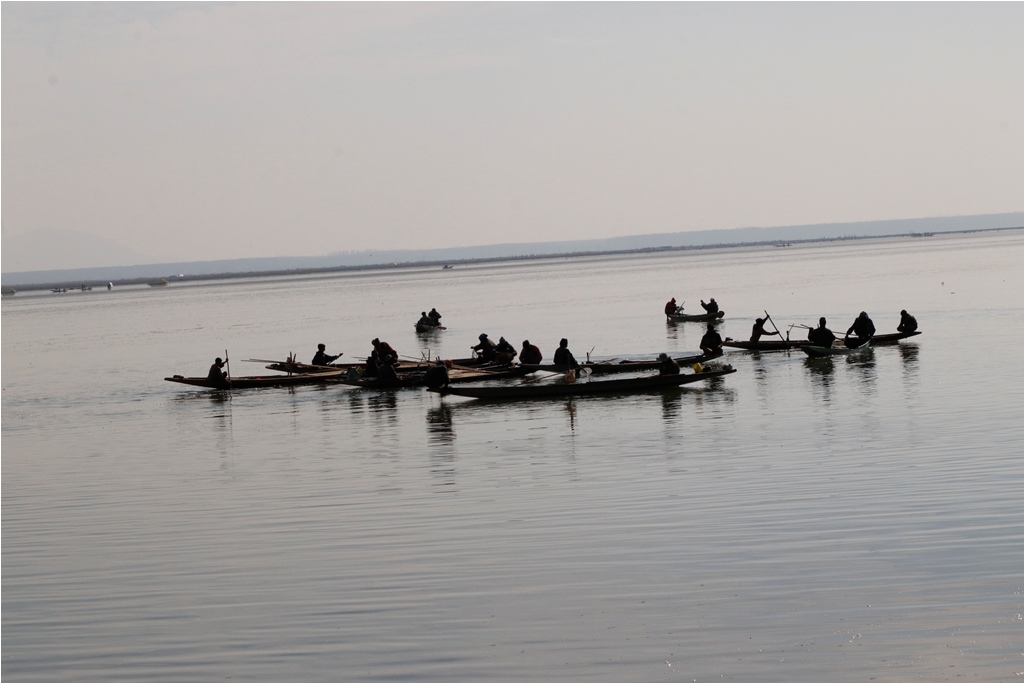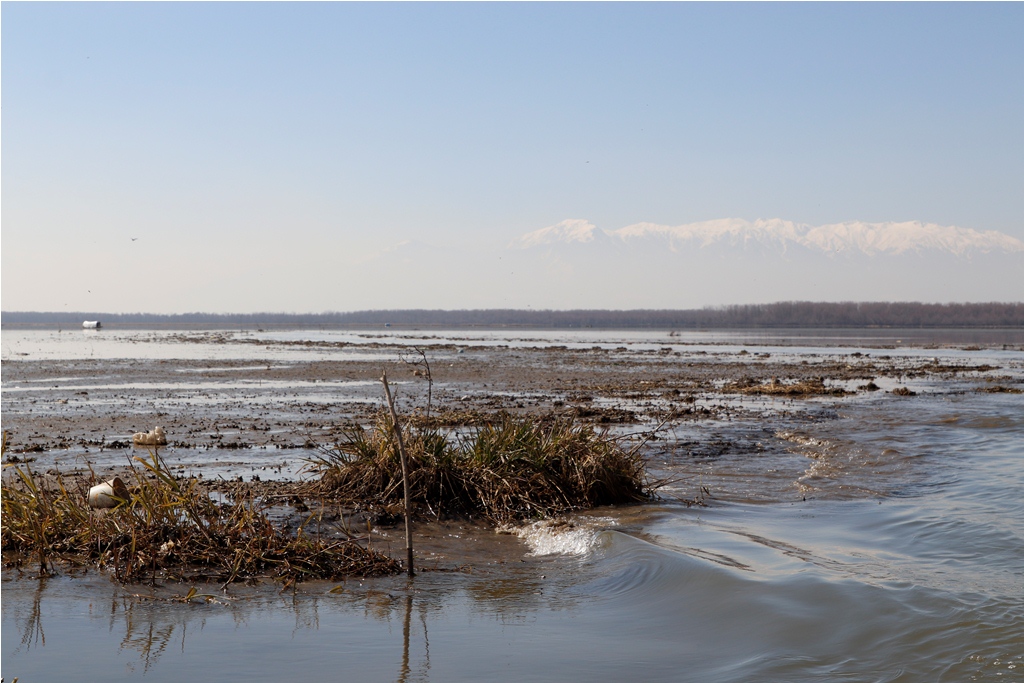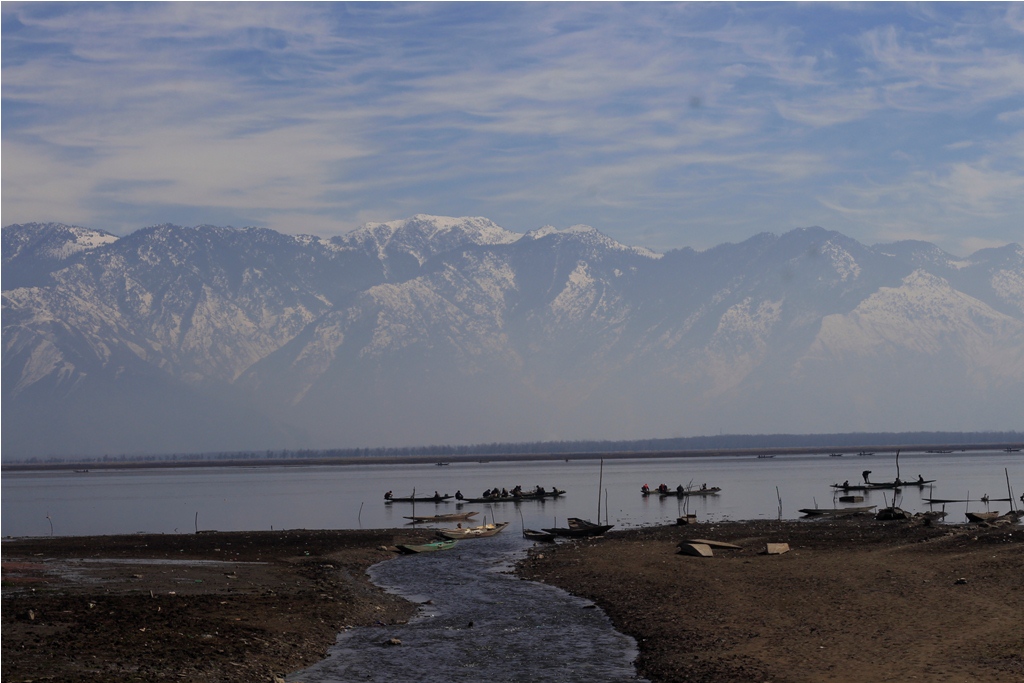Shakeel picks up his harpoon and fishing net at an ungodly hour and steps out on the winding alleyways between the scattered single-storey shanties of his hometown. With his eyes sunk deep on the path ahead, the 28-year-old man sings in undertones while going for fishing in the murky waters of Wular Lake.
The grey of the morning is yet to come, but the young fisherman’s flashing torch locates his boat on the edge of the lake. He walks carefully upon the sousing mud with the summer waters receding an inch every morning. He carefully sits the harpoon on the left of boat and strikes the match stick to burn his cigarette.
For the next five minutes he plumes the pipe in and out hastily and wears his cowboy hat to bring more substantial look to his journey. In a jiffy he shoots away the cigarette butt. In another snap, he sprouts himself away from the soil with his long oar to get going in the open water.
Spotting yonder in the dark, he says, “The fish are hard to come by, which has plunged us into despair. We toil hard in our patience here and in the end we only get Rs 400 a day. It’s very hard to meet our needs.”
Despite being one of Asia’s largest freshwater bodies, the Bandipora-based lake has lost its aura over the years. But that hardly stops Shakeel from navigating the troubled waters for his family survival.
 Fishermen Inside Wular Lake
Fishermen Inside Wular Lake
At 7am, the fisherman returns home with prized catch. The harvest, he rues, is too little to what they used to collect a decade back. He remembers the joy of watching a load of fish stacked on the boat when he was young – 10 years back. “We may cut our spendings, but what about five years from now? How will we survive? All our life depends upon this lake,” says Shakeel dismayed by the prospects.
Strangulated by siltation and enmeshed polythene, the lake—a source of livelihood for almost 37 villages—has now become a bane for the fishermen community of Bandipora. The community’s resenting voices, however, hardly echo beyond the mountains.
During summers, the lake becomes an ostracized village due to broken road forcing the natives to ferry patients on boat. “And during winters,” says fisherman Hilal Ahmad, “the lake loses its depth making it look like a huge meadow which itself reduces the scope of fishing.”
While fishing in the troubled waters of Wular has gone grim, delicacies like lotus root or nadroo is facing existential crisis. “The influx of polythene, siltation and encroachment is the major source for the extinction of the lotus stem in the lake,” says Abdul Khaliq, a Sarpanch of a village called Bangladesh in Bandipora.
Apart from fish and lotus, Wular is also running out of water chestnut — one of its special delicacies. Chestnut extraction, says Khaliq, requires ample water “but siltation and shallowness has made it a toiling task”.
Wular natives, however, have created cesspools within the lake to make inlets for water supply and extraction of chestnuts. “But even then we fear that we might soon lose these delicacies due to diminishing depth of the lake.”
 Mess Inside Lake
Mess Inside Lake
As Wular is losing its beauty, many avian guests have stopped arriving in Bandipora. Earlier, birds would fly over the lake for habitat and food. They would dive down to its interface and beak into the waters to eat their fill. Now either they’re wary of polythene getting stuck to their beaks or they don’t find it enchanting anymore because of absence of fish or the trash floated around.
“Wular has become a polythene dumping site,” laments fisherman Abdul Rashid. “Polythene carried by Jhelum has settled into the bottom of the lake due to which lotus stem has vanished from it. At times it becomes hard to run a boat here. The only option to renew Wular is through dredging.”
A study by Wetlands International says the lake over the years has lost 45 per cent of its original area of 217.8 square kilometres. The areas of the lake were mainly converted to agricultural and willow plantation sites.
In 1987, Government of India came up with Tulbul Navigation Project under which a 439-feet-long and 40-feet-wide barrage at the mouth of the lake was to be constructed. But Pakistan objected to it under the Indus Water Treaty which halted the project.
“Since then,” says Rashid, “Wular has lost the depth due to silt accumulation, polythene and other things. The construction of the Kishanganga Hydropower Project has also catalyzed the lake crisis. You hardly find any fish in river Madhumati, which is a tributary to Wular, because water from Kishanganga hydropower project submerges in that water.”
What’s adding insult to injury is the absence of comprehensive study on annual siltation rate in Wular.
“There’s a dredging going on to clear the silt,” said an official from Wular Conservation Management Authority (WUCMA). “Willow plantation is the main cause of siltation in the lake. But we’ve successfully restored 4.5 square kilometres in two years and geo-tagged the whole 130 square kilometres area of the lake. It’s a big feat.”
 The Lost Lake
The Lost Lake
But all these initiatives mean nothing for Shakeel — the fraught fisherman who sees the imminent demise of the lake and his community’s traditional livelihood.
“I’m doing my bit to clean the lake and create awareness about it,” Shakeel says. “But it doesn’t seem to help. Wular is losing its depth and delicacy and reminds us of the times when its water would cure 100 diseases. But now, its murky water will cause 101 diseases to a person.”
Umer Ahmad Is An Independent Journalist From Kashmir